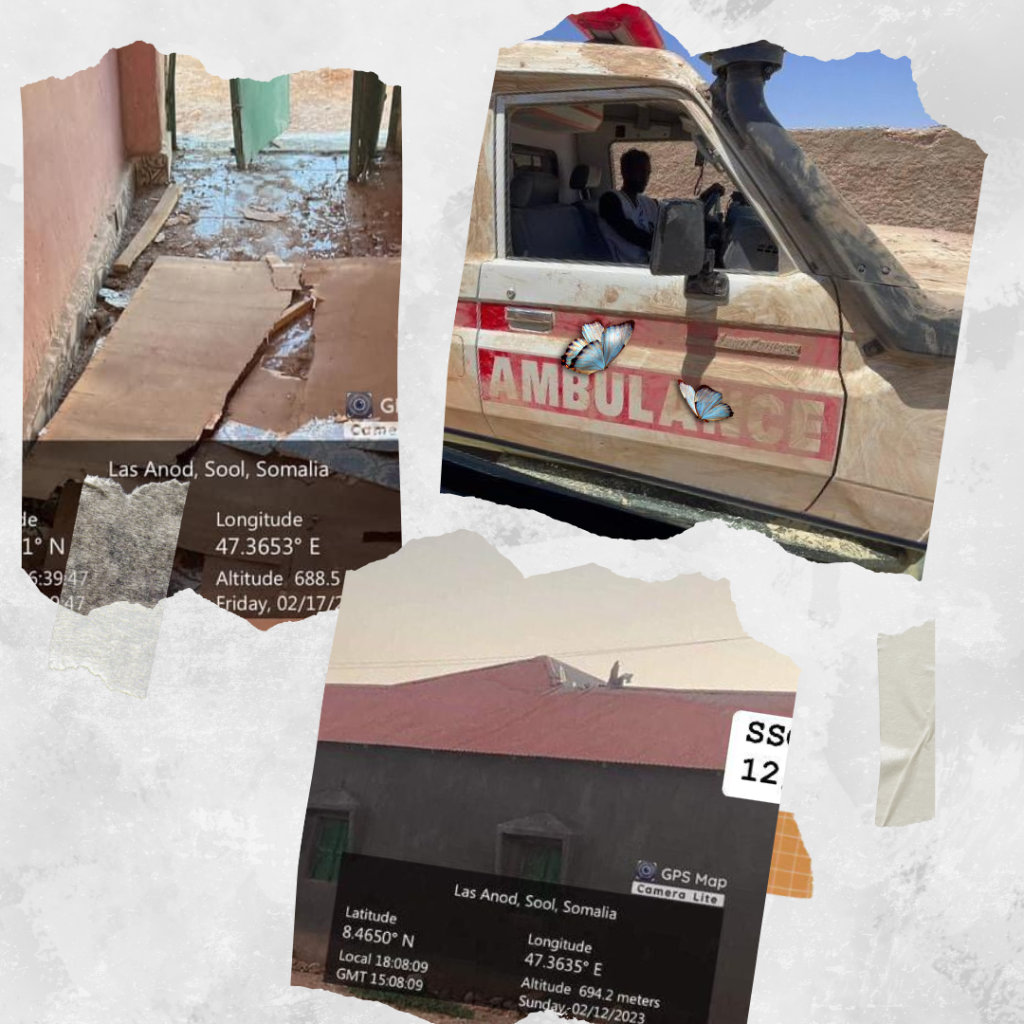Introduction
The conflict in Laascanod, a protracted battle between Somaliland and the SCC-Khaatumo state, has had far-reaching implications for the region. Beyond the immediate loss of life and displacement, the conflict has inflicted severe damage on the already fragile health system in Somalia. This article delves into the devastating effects of the Laascanod conflict on the health sector, examining the challenges faced by healthcare providers, patients, and the overall impact on public health.
Destruction of Healthcare Infrastructure
One of the most immediate and visible consequences of the Laascanod conflict has been the destruction of healthcare infrastructure. Hospitals, clinics, and medical facilities have been caught in the crossfire, resulting in significant damage or complete destruction. Essential medical equipment, ambulances, and supplies have also been lost or looted, leaving healthcare providers with limited resources to treat patients.
The destruction of healthcare infrastructure has had a cascading effect. With fewer functional facilities, patients are forced to travel longer distances to seek medical care, often in hazardous conditions. This delay in accessing treatment can lead to worsened health outcomes and increased mortality rates, particularly for women and children.
Disruption of Healthcare Services
The Laascanod conflict has severely disrupted the delivery of essential healthcare services. The displacement of healthcare workers due to fear and insecurity has created a critical shortage of medical personnel. Many qualified doctors, nurses, and other health professionals have fled the conflict zone, leaving hospitals and clinics understaffed and struggling to cope with the increased patient load.
Moreover, the conflict has hindered the transportation of essential medical supplies and medicines. Roads have become unsafe, and supply chains have been disrupted, leading to shortages of life-saving drugs and vaccines. This scarcity of medical resources has compromised the ability of healthcare providers to treat patients effectively and has exacerbated the overall health crisis.
Increased Disease Burden
The Laascanod conflict has created a fertile ground for the spread of infectious diseases. With damaged healthcare infrastructure, disrupted immunization programs, and a weakened public health system, the population is more vulnerable to outbreaks of diseases such as measles, polio, cholera, and malaria. The lack of access to clean water and sanitation facilities, often caused by conflict-related damage, further contributes to the spread of these diseases.
Additionally, the conflict has led to an increase in trauma cases, including injuries from explosions, gunshots, and other forms of violence. The limited availability of emergency medical care has resulted in higher rates of disability and death among those affected by the conflict.
Humanitarian Crisis and Access Challenges
The Laascanod conflict has triggered a humanitarian crisis, with thousands of people displaced from their homes. These displaced populations often live in overcrowded and unsanitary conditions, making them particularly susceptible to disease outbreaks. The lack of access to basic necessities, such as food, water, and shelter, further exacerbates their vulnerability.
Humanitarian organizations and aid agencies face significant challenges in delivering assistance to those affected by the conflict. Insecurity, bureaucratic hurdles, and limited resources have hampered their efforts to provide essential healthcare services and prevent disease outbreaks.
Impact on Maternal and Child Health
The Laascanod conflict has had a devastating impact on maternal and child health. Pregnant women and newborns are particularly vulnerable in conflict zones, with limited access to antenatal care, skilled birth attendance, and postnatal care. The increased risk of malnutrition, infectious diseases, and complications during pregnancy and childbirth has led to higher maternal and infant mortality rates.
Moreover, the conflict has disrupted immunization programs, leaving children unprotected against preventable diseases. This has resulted in a resurgence of vaccine-preventable diseases, such as measles and polio, with potentially catastrophic consequences for child health.
Impact on Healthcare Personnel
Healthcare workers have not been spared from the impacts of the Laascanod conflict. Many doctors, nurses, and other medical staff have been forced to flee the region due to safety concerns, leading to a severe shortage of trained professionals. Those who remain often work under extreme conditions, with limited resources and constant threats to their safety. The psychological toll on healthcare workers is profound, as they are continually exposed to violence and suffering. This situation has led to burnout and a decline in the quality of care provided to patients.
Disruption of Medical Supply Chains
The conflict has severely disrupted medical supply chains, making it difficult to procure essential medicines, medical equipment, and supplies. Road blockades, security checkpoints, and ongoing fighting have hindered the transportation of medical goods to Laascanod. As a result, healthcare facilities face critical shortages of antibiotics, vaccines, and other life-saving medications. The lack of supplies has hampered efforts to manage common illnesses and prevent outbreaks of infectious diseases, leading to higher morbidity and mortality rates.
Increase in Health Issues
The protracted conflict has exacerbated a range of health issues in Laascanod. Trauma injuries from violence and landmines are prevalent, overwhelming the limited surgical capacity of local health facilities. Additionally, the disruption of vaccination programs has led to a resurgence of preventable diseases such as measles and polio. Malnutrition rates have also risen sharply due to food insecurity caused by the conflict, particularly among children and pregnant women. The combination of physical injuries, infectious diseases, and malnutrition has created a complex health crisis that is difficult to address without stable and functional healthcare services.
Mental Health Crisis
The psychological impact of the conflict on the population of Laascanod cannot be overstated. Continuous exposure to violence, displacement, and loss has led to widespread mental health issues, including post-traumatic stress disorder (PTSD), depression, and anxiety. The stigma associated with mental health problems and the lack of mental health services further complicate the situation. Many people suffer in silence, unable to access the care they need to cope with the trauma. This hidden crisis has long-term implications for the social and economic stability of the region, as untreated mental health issues can hinder the recovery and development of individuals and communities.
Strain on Public Health Programs
The conflict has disrupted essential public health programs, including immunization campaigns, maternal and child health services, and disease prevention initiatives. Immunization rates have plummeted, leaving children vulnerable to preventable diseases. Maternal and child health services have been severely affected, with pregnant women unable to access prenatal care or safe delivery services. The interruption of disease prevention programs has increased the risk of outbreaks, further straining the health system. The inability to maintain these critical public health programs undermines long-term health outcomes and contributes to the cycle of poverty and illness.
Humanitarian Response and Challenges
Humanitarian organizations have stepped in to provide emergency health services and support to the affected population. However, their efforts are often hampered by security challenges, restricted access, and funding constraints. Delivering aid in conflict zones is inherently risky, and humanitarian workers frequently face threats to their safety. Despite these challenges, their presence is crucial in addressing the immediate health needs of the population and supporting the recovery of the health system. Coordination between local health authorities and international organizations is essential to ensure an effective and sustainable response to the health crisis.
Conclusion
The Laascanod conflict has inflicted immense suffering on the people of Somalia, with the health sector bearing the brunt of the devastation. The destruction of healthcare infrastructure, disruption of services, increased disease burden, and humanitarian crisis have created a perfect storm for public health. Addressing the health consequences of the conflict requires a comprehensive and multi-faceted approach, including rebuilding healthcare facilities, supporting healthcare workers, strengthening immunization programs, and improving access to essential services. It is imperative that the international community and humanitarian organizations prioritize the health needs of the affected population and work together to mitigate the devastating impact of the Laascanod conflict on the health system.

